During the twentieth-century movement for black rights, it was not uncommon for African American leaders and their associates to be offered money, jobs, and political appointments in exchange for either ceasing their political activities or actively subverting the efforts of other black activists. For example, some accounts report that A. Phillip Randolph, founder of the first officially recognized black labor union and one of the organizers of the 1963 March on Washington, was at one point offered a blank check by the Pullman Railroad Company in exchange for cessation of his organizing of black railroad workers. According to published accounts, Randolph was greatly offended by the implication that he could be “bought off” and returned the check, but only after writing on it, “Negro Principle: Not for Sale” (Santino Reference Santino1983; Reference Santino1989).
The tension of Randolph's position—between personal gain and the best interest of black Americans as a group—was not a unique one. Contemporary American politics easily supplies examples of inducements of personal gains for individual black Americans at the cost of the political power of the black community. Some examples are high profile and salacious, such as the allegations that Republican Christine Todd Whitman's 1993 New Jersey gubernatorial campaign paid black preachers in the state to refrain from mobilizing their congregations for the Democratic incumbent, Jim Florio, who had been endorsed by many black community leaders. Such high-profile cases are illustrative of a more general and fundamental problem of group-based politics: how to prevent members of the group—whether they be movement participants, elected officials, or ordinary citizens—from “selling out” the shared interest of the group in political choices and actions that increase the common political and social standing of the group. We turn to the case of black Americans, in particular, because they have arguably been one of the most successful groups in resolving this dilemma. Yet the answers to how they have done so and whether they will continue to be able to do so as black America grows increasingly diverse are not obvious. How might blacks be able to enforce compliance with group norms of political behavior? And what could enable even those blacks who agree with the principles of the black rights movement to choose to act on personal incentives to betray racial group norms?
This article addresses this fundamental question of group politics in the context of black political behavior. We endeavor to understand how it is that blacks navigate tradeoffs between their racial group interest and their simple self-interest. We notably depart from previous research on this topic that describes the use of racial group interest in black political decision making as a type of low-information rationality, in which the racial group interest stands in as a proxy for self-interest when true self-interest is difficult to gauge (Dawson Reference Dawson1994). Instead we ask explicitly about the navigation of known conflicts between maximizing racial group interest and one's own simple self-interest. We argue that blacks do have incentives to act in their simple self-interest and may readily accept private gains to defect from the expected racial group norms of political behavior—but only under specific informational conditions. Crystallized and intense in-group norms and the processes of racialized social pressure around those norms, we argue, are central to understanding why black Americans act on racial group interests in exchange for satisfying individual self-interests. We test our model of how group and self-interest conflict is navigated using a series of experiments that vary both the personal incentives for defecting from group interest and the amount and kind of peer monitoring around a political behavior that is well defined by in-group norms. We find that, in the absence of social monitoring, defection is not uncommon, but that racialized social pressure—as demonstrated by monitoring signals from other blacks—has a unique ability to rein in such defection. We also identify attitudes about the group and the value of the incentive that moderate the effects of personal incentives and social monitoring. We conclude by discussing the implications of our results for both black politics and the group-based politics of other social groups.
BLACK POLITICS—ROOM FOR GROUP AND SELF?
Much of what we know about the empirical link between (racial) group interest and black political decision making stems from Dawson's (Reference Dawson1994) work on the “black utility heuristic” (see also Gurin, Hatchett, and Jackson Reference Gurin, Hatchett and Jackson1989). Dawson argues that the central importance of race to black political decision making represents a form of low-information rationality. Arguments about low-information rationality generally invoke the notion that individual citizens cannot access and process all of the relevant information about their potential political choices and thus use heuristics, or information shortcuts, to infer how choices relate to their self-interest (e.g., Lupia Reference Lupia1994; Popkin Reference Popkin1991). In this vein, Dawson argues that African Americans regularly rely on racial group interest, because it is their most salient known interest, as a proxy for their own individual interests.
Indeed, many studies have linked the key measure from Dawson's study—linked fate, or subscription to the notion that what happens to blacks generally affects oneself as an individual black person—to an array of political outcomes, from policy positions to voter turnout (Dawson Reference Dawson1994; Gurin, Hatchett, and Jackson Reference Gurin, Hatchett and Jackson1989; Tate Reference Tate1993 ). Yet, some have challenged the notion that group interest is always the default for black political decision making (e.g., Cohen Reference Cohen1999). White (Reference White2007), importantly, has shown that the relevance of racial group considerations to black political decision making is context specific and dependent on whether political choices are communicated in a way that makes their implication for the racial group clear and unclouded by subgroup differentiation.
In this article, we make two claims. First, although the notion of the black utility heuristic is a useful framework for understanding black political decision making under conditions of low information, “linked fate politics” falls short in explaining decision making where blacks are faced with perceptible tradeoffs between their own self-interest and the interest of the racial group. Second, we argue that such circumstances are not uncommon. They are relatively easy to identify in social choices. Consider, for example, that when evaluating housing options, African Americans have been shown to express a preference for neighborhoods with significant numbers of other African Americans (Charles Reference Charles2000; Krysan and Farley Reference Krysan and Farley2002) and with low crime rates, good public schools, and quality housing stock (ERASE Racism 2012; Harris Reference Harris1999; Krysan, Couper, and Farley Reference Krysan, Couper, Farley and Forman2009). What guides this choice of housing when these considerations directly conflict with one another, which they often do? The logic extends to explicitly political choices. Why should middle-class black Americans not perceive some tension between their own self-interest and support for redistributive social welfare programs? Or why should those who strongly favor anti-abortion stances not desire to support the (Republican) candidates who endorse those positions? The standard answers are likely ones that would invoke a strong commitment to a norm of racial group solidarity. But why is it that some blacks, even those who claim to be loyal group members, do, in fact, defect from the expected group behavior while others do not? And how is it that blacks are able to maintain group solidarity in the face of private incentives or preferences to defect from the group norm or interest?
INTEGRATING GROUP AND SELF—SOCIAL PRESSURE AROUND INTENSE AND CRYSTALLIZED NORMS
To understand how African Americans navigate political circumstances in which the choice before them involves some perceptible conflict between maximizing private or personal benefits and maximizing what they and most other blacks believe is in the best interest of the group, we turn to the concepts of group norms and social pressure. We argue that clear and common understandings of in-group expectations for the political behavior of blacks—well-established group norms—and of likely social consequences for defection from the group norms place significant constraints on blacks’ political behavior. In particular, when political expression can be publicly observed by in-group members, the costs of defecting from understood norms and practices of the group are about loss of standing within the in-group, which implies both a value to that consequence and an understanding that other members of the group are both likely to be aware of and to punish the defection. Although our model most directly explains public and not private forms of political expression, it is both a general model of how tensions between group interest and individual interest are navigated and one that helps explain the maintenance of black political solidarity in the United States.Footnote 1 That is, we are laying out conditions under which group and self are navigated in a way that produces a high degree of adherence to the group. Hence, we motivate the model with both general expectations and justifications for some of those expectations from the particular experience of black Americans.
In the case of black Americans, we expect that blacks are constrained from following strict self-interest by the social costs incurred when other blacks question their commitment to or standing within the group. Moreover, we argue that such social pressure can be internalized, creating an individual belief in black solidarity that is also constraining and works to prevent self-interested behavior; that is, acceptance of the importance of group solidarity represents an important individual-level commitment to group-based norms of collective political behavior. Lastly, we emphasize that there are limits to the power of black social pressure—importantly, that there is a political “there, there.” In line with social psychological research on group norms, we argue that social pressure must work in conjunction with intense and crystallized norms of black political behavior (Cialdini, Reno, and Kallgren Reference Cialdini, Reno and Kallgren1990). From this follows an expectation that it should be quite difficult to enlist racialized social pressure to induce blacks to behave in ways counter to their understanding of well-established norms—to subvert group interest because the group is suddenly saying it is okay. In making all of these arguments, we point to the way in which the degree of enduring segregation that has marked the black experience in America has enabled the sort of social connections and institutions that facilitate this process.
Social Pressure in Political Choices
There has been a recent resurgence in the idea that social pressure can have an important influence on mass political behavior. Some recent studies of voter turnout, for example, have focused on how social pressure in the form of shaming can influence an individual's probability of voting. Consider Gerber, Green, and Larimer's (Reference Gerber, Green and Larimer2008) demonstration that threatening to publicize a citizen's turnout record to their neighbors can increase turnout. In other words, some people are more likely to participate when they are made to believe that their behavior is likely to be observed by close others. This type of effect has been replicated over a number of studies and supports the general idea that “shaming” is an effective tool for shaping political behavior (Gerber, Green, and Larimer Reference Gerber, Green and Larimer2010).
This concept of shaming is quite similar to the idea of “reputational sanctions” that has permeated understandings of black collective action. Chong (Reference Chong1991), for example, invoked the concept to explain why individual African Americans would choose to participate in the civil rights movement, given that they likely realized that their participation was not a necessary condition for them to enjoy any benefits of the movement. Chong argued that activists valued not being seen by their peers as free-riders; thus they adhered to group expectations of political participation. It is this idea that reputational sanctions have the power to shape group members’ behavior, even when the behavior in question comes with known risk of real cost to the individual,Footnote 2 that is important in explaining group politics. And within the black community, notions of punishment—social sanctions for defection from norms of the group interest—are tangible enough that terminology for such sanctions is found in political discourse through the use of the “Uncle Tom” or “sellout” epithets. In other words, these terms are linguistic evidence of reputational sanctions for group members’ political defection (Starkey Reference Starkey2012).Footnote 3 In the realm of contemporary politics, blacks who espouse conservative and Republican political agendas, including both ordinary citizens and public figures such as Justice Clarence Thomas, Herman Cain, and Allen West, often incur the “sellout” characterization, suggesting that the social enforcement of racial group-based political norms is an enduring feature of black politics.
Intense and Crystallized Norms
Although existing work in political behavior broadly, and in black politics specifically, points to the potential political power of reputational sanctions, it has not explained what gives power to that social pressure. To offer such an explanation, we draw from social psychological research on social pressure and conformity, which suggests that norm crystallization and norm intensity are both important in determining whether or not social pressure will result in conformity with a group norm (Jackson Reference Jackson, Steiner and Fishbein1965). Crystallization refers to the degree to which an expectation of behavior, or a norm, is understood as agreed on among group members. Lower norm crystallization has been linked to decreased potential for a message of social pressure to lead to compliance with the norm (Cialdini, Reno, and Kallgren Reference Cialdini, Reno and Kallgren1990). Similarly, norms are perceived as more or less important to the functioning of the group—to have higher or lower intensity. Concerns about reputational sanctions for violations of less intensely held norms are likely to be discounted, because individuals calculate that their deviations from the norm may likely go unnoticed or ignored; violations of more intensely held norms are more likely to deliver reputational costs.
Using this norm framework offers a causal mechanism for the effectiveness of the “shaming” get out the vote (GOTV) studies referenced earlier. Voting in the United States seems characterized generally by high crystallization: Most Americans are likely aware of considerable agreement in society with the notion that voting is an important civic duty. It is also, however, characterized by low intensity: Most are also aware that not only do many Americans regularly not vote but also that the information of who does and does not vote is typically difficult to discover—suggesting that the norm of voting is not a preoccupation of the public. Thus, the mechanism to increase the shaming messages’ effectiveness is likely to increase the perceptions of intensity of the norm of voting. By threatening to publicize whether a citizen votes or not to his or her neighbors, the message is not communicating new-found information about the desirability of voting, but of increased chances of reputational costs for not voting.
In the case of black Americans, we argue, that there are norms that meet the criteria of both high crystallization and high intensity—that there are widely held and historically entrenched expectations within the community about how group members are to behave politically. It is these sorts of norms that stand as the strongest basis for enforcing conformity through social pressure even when the group interest is in real conflict with self-interest.
A particularly clear example of a crystallized and intense political norm for black Americans is support of Democratic candidates. Data from presidential elections draw the picture in sharp relief of conformity to this norm: In no presidential election since the mid-twentieth-century realignment of the parties has a Republican candidate received more than 17% of the African American popular vote (see Figure 1). And in elections where race was not only read into the partisan identifications of the candidates, but in the candidates themselves—the Obama elections of 2008 and 2012—the Democratic candidate took even larger shares of the black vote (95% and 93%, respectively).Footnote 4 These “facts” of black political homogeneity also get reified by media coverage of elections and campaigns, which consistently describes African Americans as the most loyal voting bloc of the Democratic Party—despite a growing black middle class that might be expected to have economic interests that lead them to support Republican candidates. Supporting Democratic candidates is not only a well-understood—highly crystallized—norm but also one that is deemed important to maintain or advance the racial group's interests.Footnote 5 Because the partisan loyalty of blacks and its importance to the black community are so clear in common understandings, deviation from the group position brings with it perceptible risk of charges of “selling out” the race by expressing a different preference—despite the privacy of the actual act of casting the ballot.Footnote 6
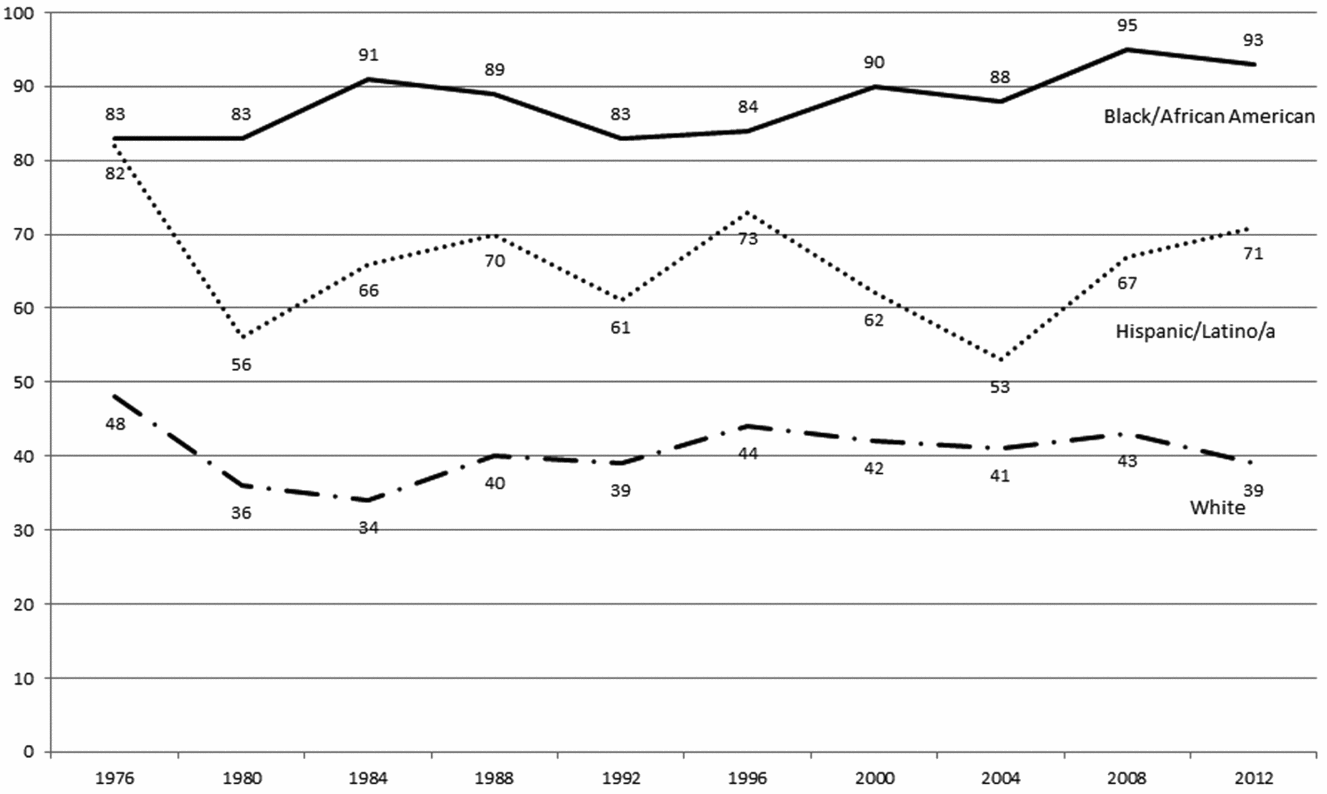
FIGURE 1. Democratic Presidential Vote Share by Race, Exit Polls
Whereas vote choice is technically private, support of candidates is not. Thus the threat of group sanctioning may well do its greatest work in the political processes—such as through political discourse and information sharing—that precede and proceed from the voting booth. Consider the unique stability of blacks’ expressed approval of Obama throughout his first term. As illustrated in Figure 2, although white Democrats’ public support for Obama began to wane as his term progressed, perhaps unsurprisingly in the face of criticisms over bailout programs and the president's push for health care reform, blacks as a group (regardless of their partisan and ideological backgrounds) remained consistently loyal to Obama throughout his first term.Footnote 7 Taken together, these opinion and vote (reporting) trends speak to the likelihood of obvious and well-understood descriptive norms of expected political behavior (see Nickerson and White Reference Nickerson and White2010) with regard to the first black president—that blacks are to be supportive in opinion and action.Footnote 8
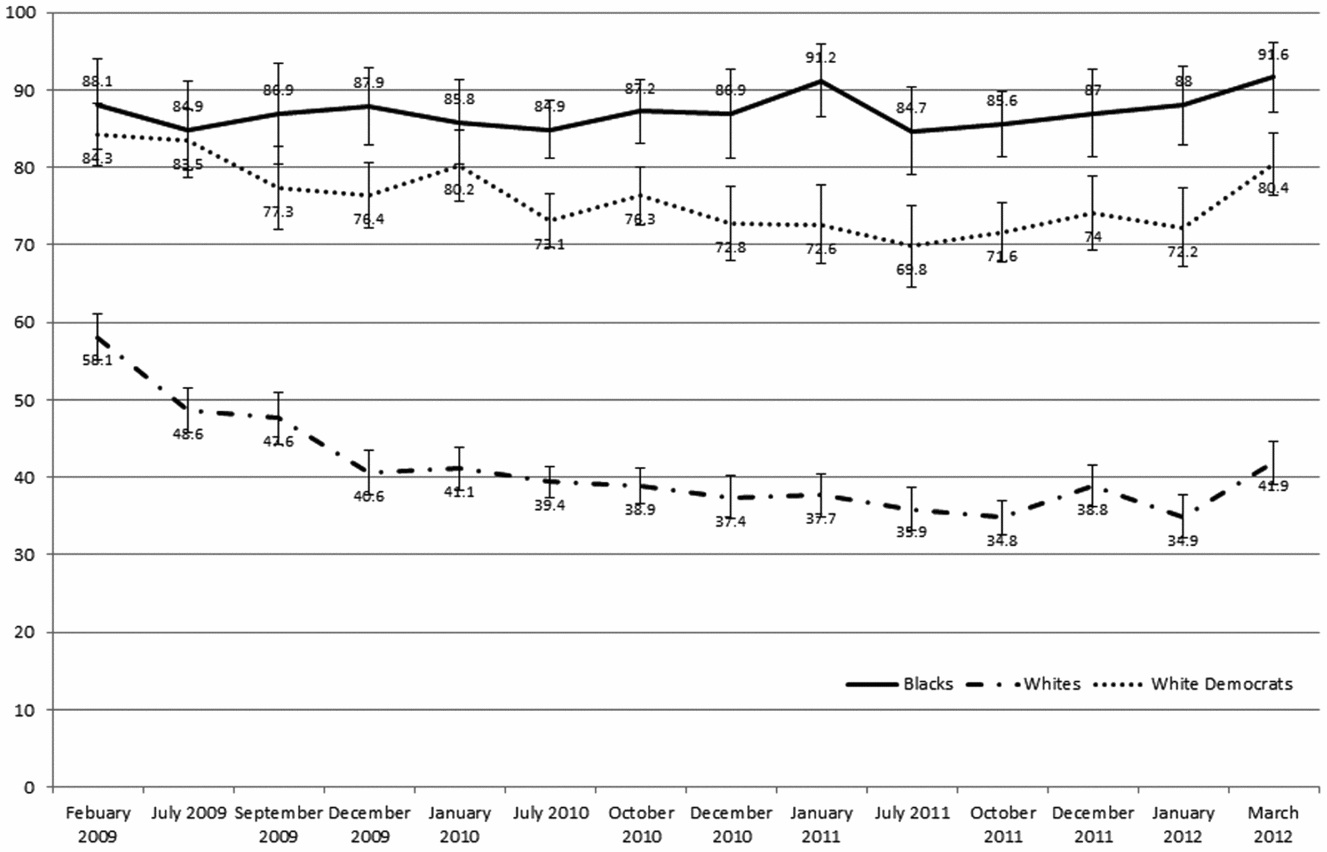
FIGURE 2. Obama's First-Term Job Approval by Race and Party
Social Location as Venues for Norm Development and Enforcement
If norm definition and development are social processes, and their enforcement comes through the exercise of social pressure within the group, then the social location of group members is also essential to understanding whether self-interest is likely to be overridden by group interest. It is in this regard that blacks seem particularly distinct from most other groups. Despite the increased integration of blacks into mainstream American society in recent decades, racial isolation still defines many daily interactions for African Americans. It is this segregation and the investment in black social networks and institutional structures that was born out of it that enable the unique degree of definition and enforcement of group-based norms of political behavior among blacks. For example, a 2009 Pew study found that nearly 60% of African American churchgoers still attend historically black churches, churches that remain predominantly filled with black members and preachers.Footnote 9 Although the proportion of black college students who attend historically black colleges and universities (HBCUs) has declined over the last 40 years, 13% of black college graduates still come from HBCUs (U.S. Department of Education, 2004). Furthermore, many of those blacks who choose to attend non-HBCUs eventually find themselves members of black social and professional organizations within these institutions (Sidanius et al. Reference Sidanius, Van Laar, Levin and Sinclair2004). This sort of racial homophily can even be seen in black social media networks. A recent study of friendship networks on Facebook, for example, found that black students were significantly more likely to have same-race social networks than other racial groups (Wimmer and Lewis Reference Wimmer and Lewis2010). Thus black Americans continue to be located and invested in black social spaces, increasing their likelihood of exposure and vulnerability to racialized social pressure around group norms.
DESIGN
To test our arguments about racialized social pressure around group norms as a constraint on black political behavior, we designed a series of experiments that enabled us to observe the tradeoffs blacks make between their racial group interest and simple self-interest under different social pressure constraints. Across all the experiments, our aim was to attain as much clarity as possible about the causal effects of both self-interest and social pressure around norms of group interest, while maintaining as much ecological validity as possible. Our designs, therefore, struck a balance between abstraction—they involved a laboratory environment and they induced self-interest through assigned monetary incentives—and reality: They leveraged the real-world scenario of the 2012 presidential election and appeared to provide subjects real opportunities to contribute financially to it. Specifically, we juxtaposed self-interest in the form of instant monetary gain with the crystallized and intense group-interest norm of supporting a political candidate, Barak Obama, whom the black community almost unanimously endorsed.Footnote 10 We independently manipulated self-interest and social pressure, enabling unconfounded assessments of the causal connection between each of them and political behavior. The experiments differed in their operationalization of social pressure, including both the form it took and the specific behavior it attempted to induce. Because of the auxiliary data collection we did inside the lab in all the experiments, we were able to observe and describe the traits of blacks willing to set aside their simple self-interest in favor of the group norm, to do the same for those who defected, and to test how and on whom racialized social pressure constrained this defection.
We deliberately chose to limit our subject pools to college students. We made this decision for several reasons. First, it was important to leverage the role of black institutions—which we have argued are central to this process within the black community—within our study. Conducting our first study on students at a historically black college or university (HBCU) enabled us to do so in a feasible and yet also realistic way. Second, limiting our study to college students helped ameliorate concerns about heterogeneous treatment effects due to markedly different socioeconomic locations. In short, we had more confidence in the assumption that college students interpret the self-interest value of a small monetary incentive in the same way than we would in making that same assumption about a broader population. Nonetheless, we expected the basic inferences about the process by which self- and group interests are traded off to be generalizable to broader African American political decision making in the context of racialized social pressure. We drew on the logic of external validity provided by Druckman and Kam (Reference Druckman, Kam, Druckman, Green, Kuklinski and Lupia2011), conceiving it as not simply “whether a specific study, if re-run on a different sample, would provide the same results [but]. . .whether ‘conceptually equivalent’ (Anderson and Bushman Reference Anderson and J. Bushman1997) relationships can be detected across people, places, times, and operationalizations.” As Druckman and Kam (Reference Druckman, Kam, Druckman, Green, Kuklinski and Lupia2011, 44) argue, ensuring that the experiment is believable, that subjects perceive that their choices are consequential, and that the experience closely replicates that of actual political decision making help meet this conceptual equivalence criterion. Our design choices were made with careful attention to these conditions. Furthermore, comparisons of our student subjects to a national random sample revealed a good deal of similarity across a range of political and social variables.Footnote 11
EXPERIMENT 1 – SELF-INTEREST AND SOCIAL PRESSURE
This first experiment tested the effects of self-interest and social pressure on blacks’ willingness to conform to racial group norms of political behavior by randomly assigning personal monetary incentives to depart from the norm and a threat of social enforcement. We implemented the study at an HBCU because it provided an especially clean experimental test of how social pressure within the black community works. Within a black institution we could be most confident of subjects’ awareness of the group norms about politics and of likely social sanctions, that the subjects’ peer social networks were almost exclusively black to enable such sanctions, and that there was an accessible institutional mechanism for “outing” defection. We took advantage of the school's student newspaper—a known mechanism for dissemination of information through these black social networks—to provide a cue to likely in-group social sanctions for deviation from a black political norm.
We used the candidacy of Barack Obama in the 2012 election as the basis for creating a black political norm-conforming action for our subjects to take: donating money to the Obama campaign. All of the 148 self-identified African American subjects who participated in the study, which was conducted approximately two months before the general election, were first asked to read and sign a consent document: After providing their consent, the subjects then filled out a pretest questionnaire and were instructed that they were to participate in a short five-minute one-on-one interview about the upcoming presidential election.Footnote 12 All subjects were told that the researchers conducting the study were political scientists from a public university who had been awarded a grant from an organization called the “Voter Turnout Project,” and that the funds from this grant were to be used to provide young people with an opportunity to contribute to campaigns. They were told that the project would provide them with $100 to donate to the presidential campaigns of Barack Obama and/or Mitt Romney and that they could allocate the money any way they chose. They could donate it all to one candidate or split it across the candidates, as long as their donations totaled $100.
Subjects were randomly assigned to receive one of three messages during the interview. In the control condition, all subjects were told this information before the interviewer directed their attention to a webpage on a nearby laptop where the donation amounts were to be entered; in the two experimental conditions subjects received a different additional message from the interviewer at this point (see Table 1).Footnote 13 For all subjects, once they determined how they wanted the money donated, the interviewer entered the amount into the website, asked them if they were sure about the donation, and then submitted the contribution. Out of a concern for allocating state money to political candidates, no money was actually donated to the campaigns. This deception was built into the study to make it seem as realistic as possible, though all subjects were debriefed and informed of the deception at the end of the study.Footnote 14
TABLE 1. Description of Experiment 1, Conditions and Hypotheses
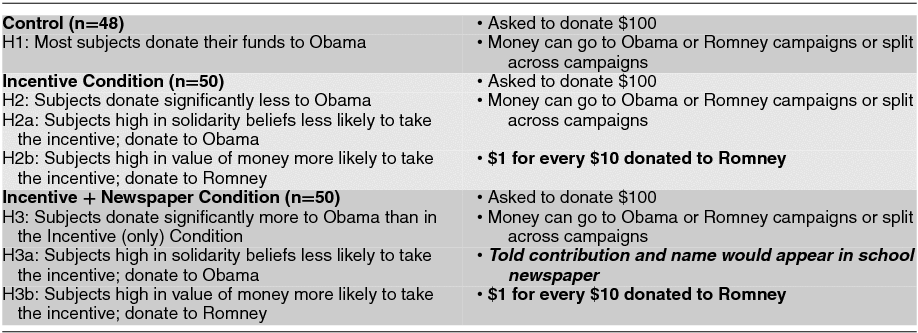
The second row of Table 1 highlights the manipulations of the first treatment condition, which we called the incentive condition. These subjects were given the same ability to allocate $100 in campaign contributions, but they were additionally instructed that the computer might provide them with an incentive to donate to one of the candidates. In the interest of fairness, the computer would randomly determine for which candidate the incentive would be offered. In reality, the incentive was not randomly assigned—all subjects in the incentive condition were provided an incentive to contribute to the Romney campaign. That is, we wanted to incentivize deviation from the black norm of behavior—contributing to Obama—with a personal monetary gain, but did not want the subjects to suspect the monetary incentive was being driven by partisan incentives. Subjects in the incentive condition were told that for every $10 they donated to the Romney campaign they would receive a $1 personal payout, implying a maximum payout of $10 if they allocated the entire $100 to the Romney campaign. These payouts, if chosen by the subjects, were actually paid in cash within the experiment. In this condition, then, we expected to induce conflict for black subjects between their individual self-interest in having money in their own pockets and their group interest in supporting the Obama campaign over the Romney campaign.
In the second treatment condition, the incentive + newspaper condition, highlighted in the bottom row of Table 1, we added a manipulation to enable us to examine the effect of social pressure in restraining self-interest-incentivized defection from the group norm. This condition was identical to the incentive condition with the exception that we informed subjects—before they were asked to make their donation decisions—that the donation would be publicized along with their name in the university's newspaper. In the context of this HBCU, this manipulation represented quite well the threat of racialized social sanctions. This university has a newspaper that is well read by the predominantly black student body, meaning that the subjects were likely to anticipate exposure of their choices to their black peers and social networks. Thus, the treatment was expected to provide social pressure to conform to the black norm of expected behavior—contributing to Obama—and reduce defection because subjects would fear the social consequences of being seen as someone who deviates from that norm.
Hypotheses
Our set of hypotheses is summarized in Table 1. The control condition, in which the subjects were simply asked to allocate the money to the candidates of their choosing, allowed us to establish a baseline contribution amount, which also acted as a gauge of the “norm” of black political behavior in the form of campaign contributions. If actively supporting Obama is a crystallized and intense racial group norm, then control subjects should choose to have the majority of the funds donated to support the Obama campaign (H1). Our most straightforward expectations across the conditions were that the introduction of personal monetary incentives (self-interest) for defection from the norm of supporting Obama should result in decreased contributions to Obama (H2), but that the effect of the incentive should be attenuated with the introduction of newspaper disclosure as a mechanism for social pressure to comply with the group norm, despite its conflict with self-interest (H3). We did not, however, expect the effects of the treatments to be homogeneous. We expected that subjects with beliefs in black group solidarity—those who have internalized the notion of the importance of the collective power of the black community and have a strong commitment to the idea that blacks should not free-ride off the efforts of other blacks—would be less likely to defect in the face of the incentive (H2a and H3a). Similarly, we expected that blacks’ nominal value placed on money (the form of the self-interest incentive offered here) should condition their responses to the treatments; those blacks who place a high value on money in their lives should be particularly susceptible to the monetary incentives (H2b and H3b).
We also examined the possible moderating effects of linked fate attitudes and party strength, because these predispositions are often implicated in the political decision-making calculus of African Americans. Our expectation was that linked fate should only differentiate subjects in the control condition—where the decision is divorced from self-interest concerns. If the previous literature is correct about linked fate as a decision-making shortcut, its influence should wane once subjects are doing the work of thinking through tradeoffs between their self-interest incentives and group interests. We considered partisan strength as another modifier of the response to the treatments, because it likely represents another form of group attachment and expected norm about the political behavior at hand. That is, in our largely Democratic demographic, those who identify strongly with the Democratic Party should also be constrained from acting on the self-interest incentive to give to the opposing party's candidate. Yet, we expected that this pattern would actually be a function of racial considerations, and thus we ultimately embedded the moderators in a single test.
Results
Figure 3 presents the results of Experiment 1: the average amount of money allocated to the Obama campaign across each of the experimental conditions. Comparison of these amounts allows us to assess hypotheses H1, H2, and H3. Consistent with our expectation that support for Obama would be a highly crystallized and intense norm (H1), subjects in the control condition demonstrated a clear preference for supporting the Obama campaign, with a mean donation of $90. Indeed, in the absence of any incentive to do otherwise, most of the subjects in this condition allocated all of the money provided to them to the Obama campaign; only 2% of the control condition subjects gave the Obama campaign less than $50, and about 75% of subjects gave the Obama campaign $90 or more. Thus, these results reflect the “norm” of black behavior present within our subject population and provide a useful benchmark with which to compare the results of the experimental conditions.
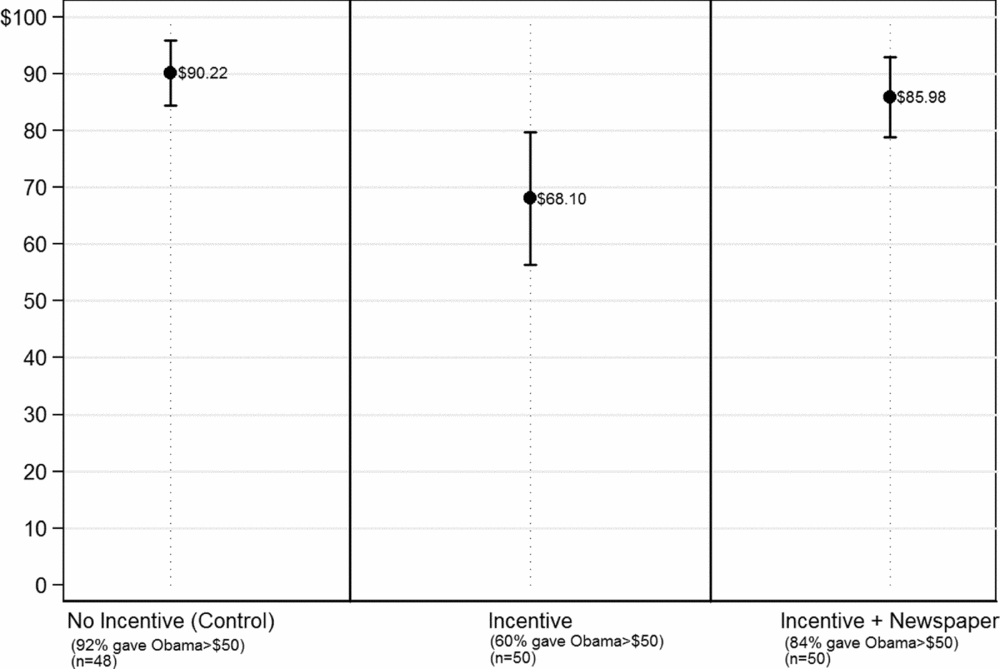
FIGURE 3. Experiment 1, Obama Contribution by Experimental Condition (95% Cl)
Within the incentive condition, in which subjects were offered the self-interest payout of $1 for every $10 they allocated to the Romney campaign, we expected less adherence to the group-interest norm of supporting Obama (H2). Indeed, in the face of an incentive to defect, allocation to the Obama campaign dropped off significantly as compared to the control condition.Footnote 15 As displayed in the second column of Figure 3, the mean Obama contribution dropped by more than $20, to $68. Twenty-two percent of subjects maximized their self-interest and donated the entire $100 to the Romney campaign. In the face of self-interest incentives to defect, individuals who would have ordinarily behaved in a manner consistent with the expected group norm of behavior (supporting the Obama campaign) defected and chose instead to support the Romney campaign.Footnote 16
If social pressure can prevent this defection, we should observe an attenuated effect of the incentive in the form of a smaller difference from the control condition in Obama contribution amounts in the incentive + newspaper condition than in the incentive-only condition (H3). Indeed, we observed, as illustrated in Figure 3, that when the incentive was combined with information that the donations would be published in the university's newspaper, defection from the group norm of supporting Obama decreased significantly. Mean contributions to the Obama campaign in the incentive +newspaper were $18 higher than in the simple incentive condition. Contributions in the incentive +newspaper condition were also statically indistinguishable from the control (p ≈ .49), suggesting that this social pressure resulted in a return to normalized behavior.
These findings suggest that, although black political solidarity is vulnerable to the influence of self-interest incentives, social pressure can be an effective tool for keeping defection from the group norm in check.Footnote 17 They are suggestive of the process by which social location in black institutions facilitates group-interest political behavior—such as protest and rally attendance, petitioning, or campaign activity—a pattern repeatedly demonstrated in observational studies. Social location in these organizations makes those who might deviate from the group norms easily subject to social sanctions.
Moderators of Loyalty to Obama
The responses to our pretest questionnaire enabled us to answer questions about the mechanisms of the processes of defection and social constraint. The predispositions of those who defected in the face of self-interest incentives and those who responded to social pressure shed light on how this political process unfolds. We examined, separately across each of the experimental conditions, the relationships between blacks’ willingness to contribute to the Obama campaign and the individual-level dispositions that we expected to condition the responses to the treatments. We began with the moderators we expected to be central—internalized notions of black solidarity and the individual-level value placed on money. We then considered linked fate and Democratic partisan strength.Footnote 18
Enforcement of Black Group Solidarity
We expected that long-term black political socialization around adherence to group interest norms should result in internalized beliefs in black political solidarity. We thus expected such beliefs to condition responses to the treatments in a similar manner to social monitoring, making subjects less likely to accept the self-interest incentive to deviate from the group norm (H2a and H3a). We operationalized solidarity beliefs with a measure of subjects’ level of agreement with the appropriateness of referring to blacks who support the causes of white Americans at the expense of causes supported by other blacks with the social sanction terms “sellout” or “Uncle Tom.” This measure reflects blacks’ acceptance of social pressure to enforce behavior in the group's interest, capturing the solidarity attitude's connection to the social process of norm enforcement.
We tested these expectations by comparing, across the conditions, the average contributions of those who rejected the use of the social sanction terms and of those who found them (at least sometimes) appropriate. The results presented in Figure 4 generally support our expectations that solidarity beliefs are key to constraining self-over-group behavior. Across the experimental conditions there was very little change in Obama contributions among those blacks who saw social sanctioning for group defection as appropriate. Even in the face of monetary incentives to defect from the group norm of behavior, blacks who believed in the use of these sanctions continued to contribute to the Obama campaign. Thus, it seems that internalized beliefs in the use of social sanctions for preventing defection, much like social pressure, can be an effective tool for preventing black defection from group norms of political behavior.
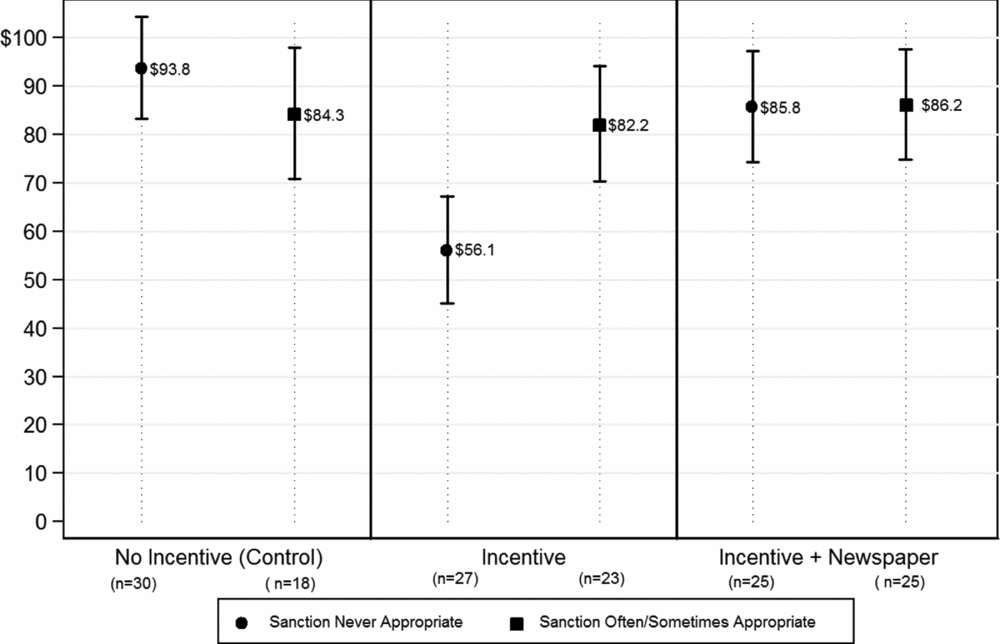
FIGURE 4. Obama Contribution by Condition and Belief in the Enforcement of “Sellout/Uncle Tom” Sanctions (95% Cl)
The results for blacks who did not see the use of sanctioning terms as appropriate were more nuanced. These individuals were not so constrained when their behavior was essentially private: They were much more likely to exhibit self-interested behavior in the simple incentive condition. Their average contribution to the Obama campaign dropped from $93 dollars in the control condition to $56 in the incentive condition. Yet, when faced with a relevant mechanism for enabling social sanctioning—that is, when told that their contributions would be publicized to their peers in the university's newspaper—even those who rejected the use of sanctioning terms conformed to the group norm. Their average contribution to the Obama campaign in the incentive + newspaper condition was $86, an amount much higher than what they gave when faced only with the self-interest incentive, and far closer to and statistically indistinguishable from the amount allocated by their counterparts in the control condition (p = .35). It seems that even those who rejected the propriety of sanctioning terms were constrained by the potential to face such social sanctions. Thus, regardless of what blacks normatively think about this method of enforcing group norms, awareness of social sanction potential, combined with the presence of mechanisms for delivering them, is effective in preventing group defection.
The Importance of Money
Given that our individual incentives came in monetary form, we had a straightforward way to test the moderating effect of the personal value of that incentive.Footnote 19 We measured the value of money to each individual with a scale created from two questions, one that assesses the extent to which the individual bases his or her own happiness on the amount of money possessed and another that measures the subject's willingness to abandon friendships if they stand in the way of making money. We expected that individuals who place greater value on money should be more likely to accept monetary incentives to defect from the group norm (H2b and H3b).
Again, we used simple mean comparisons across the conditions to test our expectations, this time dividing the subjects into “high” and “low” valuers of money. The results for this analysis, presented in Figure 5, in fact show that the only differential produced by the value an individual places on money is his or her level of immunity from the threat of social sanctions. That is, although both low and high valuers defected in the incentive-only condition, giving significantly less than their counterparts in the control group, only those who place a high value on money continued to defect in the face of the threat of social sanctions provided in the incentive + newspaper condition. In fact, the results are suggestive that individuals exposed to the social pressure treatment who place a relatively low value on money were almost entirely constrained by the sanction threat. These results speak to the relative value of the self-interest gain in conditioning the tradeoffs made between group and self. It mattered that, although we offered equal individual incentives, not all subjects valued them equally. The important conclusion here is that groups may increase group interest behavior in part by working to define possible self-interest incentives as less valuable, making group members more susceptible to the effects of social pressure in choosing group interests over individual gains.
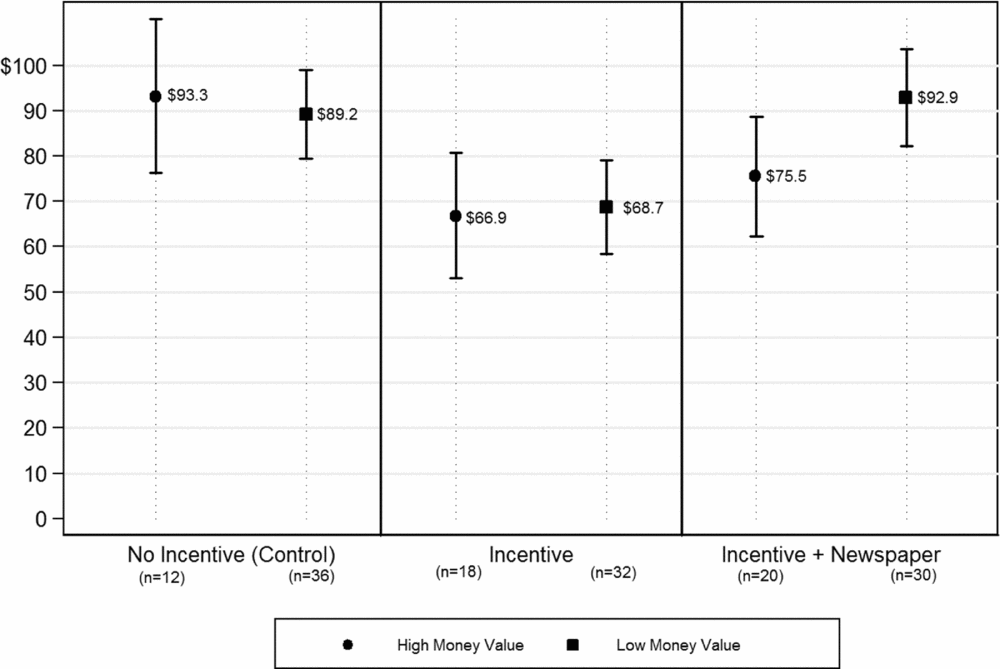
FIGURE 5. Obama Contribution by Condition and Value Respondent Places on Money (95% Cl)
Linked Fate
Again, we expected that linked fate is not a tool that helps blacks make political decisions that involve tradeoffs between self and group interests. Thus, we did not expect it to moderate our treatment effects. We did, however, expect linked fate to be an important predictor of black political behavior in the absence of cues to tradeoffs; we thus fully expected variation in levels of linked fate among the subjects in the control condition, with those high in linked fate likely to employ that predisposition to give larger amounts to Obama. Comparing means of amounts given to Obama by those high in linked fate and those low in linked fate across the experimental conditions supports these expectations. As displayed in Figure 6, although those high in linked fate gave, on average, a bit more than those low in linked fate in the control condition, linked fate seems orthogonal to contribution decisions in the other conditions. Indeed, the only significant result here is a statistically significant drop in contributions among blacks high in linked fate from the control to the incentive condition. In other words, at least for some blacks, the ties that bind them to identify with the group are no match for the power of self-interested financial incentives. The power of social pressure, however, works for all blacks—no matter how linked they claim to be to the racial group. This evidence is consistent with our argument that the linked fate paradigm may not explain the work of race in political circumstances where blacks must navigate between group and self.
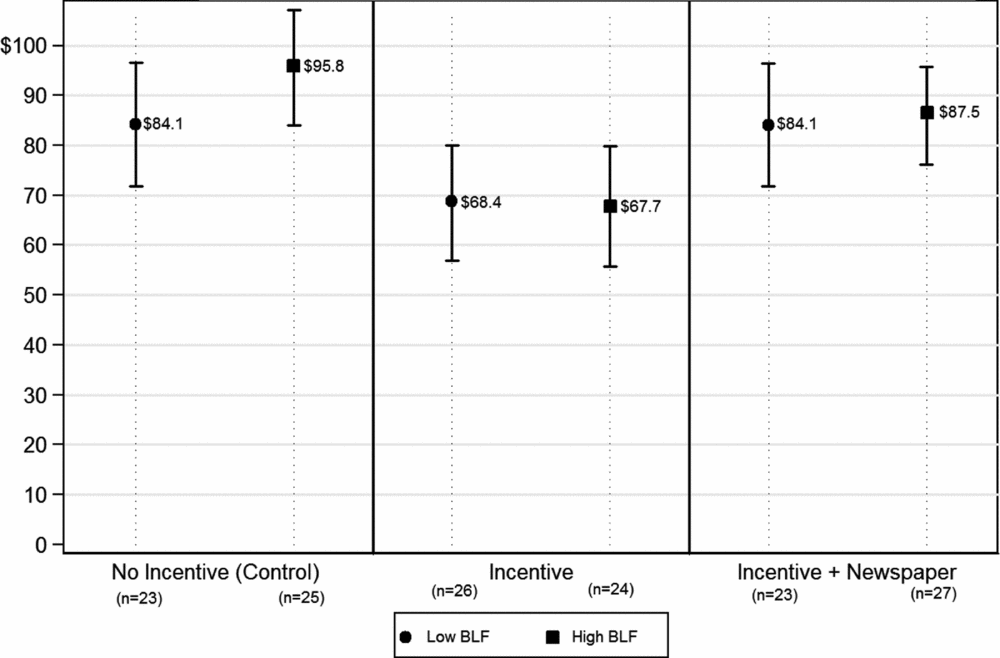
FIGURE 6. Obama Contribution by Condition and Black Linked Fate Disposition (95% Cl)
Democratic Party Strength
Because contributing to Obama is not just a racialized political choice but a partisan one as well, we would expect those who identify more strongly as Democrats to be less susceptible to the influence of incentives to defect from the group norm of supporting the Democratic candidate. Indeed, mean differences in Obama contributions among strong and weak partisans across the experimental conditions are not entirely inconsistent with this argument. As displayed in Figure 7, the contributions amounts of those who described themselves as weak Democrats dropped off (from the control) more than those of strong partisans in the incentive condition. The incentive + newspaper condition, however significantly reduced defection across all blacks regardless of Democratic partisan strength.
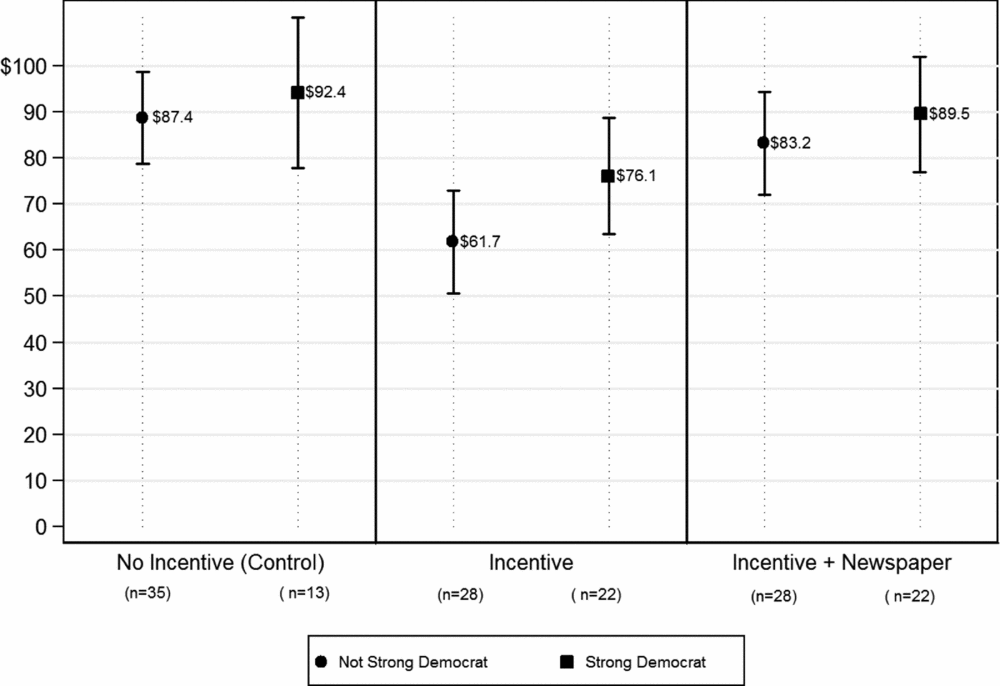
FIGURE 7. Obama Contribution by Condition and Party Strength (95% Cl)
We question, however, the notion, as those who claim a postracial America might suggest, that blacks’ support for Obama has more to do with their identities as Democrats than their racial identity. Thus, our final analysis embedded all of our moderators into a simple linear model predicting amounts given across the conditions. Those results, as displayed in Table 2, underscore that it is the racial component of Democratic identification that does the real work in this context. The relevant statistical tests here cut across the experimental conditions, shown across the rows of the table. The only two statistically significant differences are attached to the moderators we identified as key: internalized beliefs in black solidarity and relative value of the self-interest incentive (money). This result indicates that, after the differences in amounts given across conditions that are attributable to these attitudes are controlled for, neither linked fate nor partisanship conditioned the treatments’ effects on amounts contributed to Obama. In sum, not only is social pressure highly effective at preventing defection from racial group norms of political behavior but it also outperforms other key factors linked to patterns of black political behavior: racial group identification and strength of support for the Democratic Party.
TABLE 2. Predictors of Amount Contributed to Obama by Experimental Condition
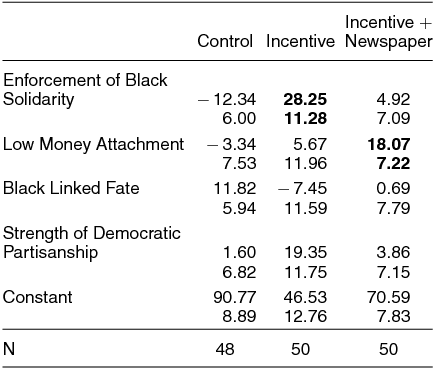
Note: Entries are OLS coefficients from simultaneously estimated models. Bolded results indicate a statistically significant (p < .05, two-tailed, χ2) slope change from the control condition.
EXPERIMENT 2 – “RACIALIZED” SOCIAL PRESSURE
Although Experiment 1 clearly demonstrated the power of social pressure, its design did not directly test whether that social pressure needs to be from the in-group. In the context of a black institution, the social pressure that blacks faced was obviously exerted by the subjects’ black peers. Could social pressure from the out-group—namely, whites—matter in the same way? In addition, does the context of social pressure matter? In the first experiment we threatened to reveal defection to a wide audience within a social institution—which would likely include both strangers and close associates and/or friends of the subjects. If our theory of group politics is correct, however, we would expect that not only should social pressure exerted by one's friends and family matter but also that social pressure from in-group members with no personal connection should be effective in constraining self-interested behavior. Experiment 2 was designed to address these issues. It directly tested the effects of pressure from in-group members—what we call racialized social pressure in this context—against social pressure from out-group members, using complete strangers to the subjects as the social pressure cues. This experiment again made use of the 2012 Obama candidacy; it again used the action of contributions to the campaign as the behavior consistent with the black group interest, and it offered monetary incentives to defect from contributing to induce a self-interest conflict.Footnote 20
Subjects in this experiment were 106 black students from a predominantly white university in the Midwest. They were randomly assigned to one of three conditions: a control or one of two treatments. Across all of the conditions subjects were asked to fill out a short pretest questionnaire and were then instructed that they were going to participate in a brief interview about the current presidential campaign. Subjects then entered a hallway where they approached an interviewer sitting at a table outside of a classroom. During the course of the interview, participants were told that the researchers conducting the study were awarded a grant from an organization called the “Voter Turnout Project” and that the funds from this grant were to be used to provide young people with the opportunity to contribute to presidential campaigns. Each subject was then given $10 in one-dollar bills and instructed to enter the classroom where there were two contribution boxes—one labeled “Obama” and the other labeled “Romney.” Subjects were told that if they would like to make a contribution to the campaigns of either of the candidates, they could do so by putting money into the respective contribution boxes and that the “Voter Turnout Project” would match every dollar they contributed with $10 additional dollars, up to $100. Finally, they were told that they were in no way obligated to contribute; if they wanted to keep the money they should feel free to do so. All subjects were asked to sign a sheet on entering the room acknowledging that they had received the money and were given approximately 30 seconds to sign and make whatever contribution they chose. The subjects then left the room and were asked to complete another short questionnaire.
For subjects in the control condition, this protocol described their entire experience—they participated in the interview and entered the contribution room alone. Subjects in the treatment conditions, however, were told that they would be interviewed along with another student. The other student was positioned in a nearby classroom and approached the interviewer at the same time as the subject. In all cases, this other student was a confederate. The condition designed to create racialized social pressure, the black confederate condition, paired the subject with a black student of the same sex. The white confederate condition paired the subject with a white student of the same sex. We confirmed that the confederates were strangers to the subjects through after-reporting by the confederates.Footnote 21 Confederates and subjects were simultaneously given the protocol instructions and each given $10 in one-dollar bills. The confederate and subject were then instructed that they were to enter the contribution room together. The social pressure treatment was implemented by the confederates’ actions on entering the room: They walked immediately to the Obama box; said, “I am giving all of my money to Obama;” inserted the entire $10 in the box; and then signed the sheet acknowledging that they had received the money. In all cases the confederate completed the protocol before the subject made any contribution. The confederate waited until the subject was done before leaving the room to induce a sense of social monitoring. When the subject was done, both exited the room and were asked to complete the final questionnaire.Footnote 22
Hypotheses
Our expectations for this experiment were simple. In the control condition, which lacked any social pressure, we expected that most blacks would maximize their personal gain by keeping most or all of the money given to them (H4). If our argument about the process of conformity to group-based norms was correct, however, we expected significantly more to be given in the black confederate condition (H5), but not in the white confederate condition (H6). These expectations, again, rest on the argument that supporting Obama is defined by an in-group norm of political behavior and that the consequence of deviating from such a norm is a social sanction within the black community. In other words, black subjects were expected to be concerned uniquely about having other blacks question their commitment to racial group goals and be constrained accordingly.Footnote 23
Results
We tested our hypotheses by comparing the mean Obama campaign contributions across each of the experimental conditions. The results are presented in Figure 8. Our expectation about the unique ability of racialized social pressure to constrain black political behavior away from self-interest is supported by these results. When black subjects entered the contribution room alone, they were perfectly willing to keep most of the money given to them, supporting H4. Subjects in the control group contributed an average of only $3.74 to the Obama campaign.Footnote 24 Almost one-third of them kept all the money for themselves. Consistent with H6, the presence of a white student who made their intentions to support Obama very clear had no discernible effect. Subjects in the white confederate condition gave an average of only $4.45 to the Obama campaign, netting a difference that is substantively small and statistically indistinguishable from the control (p ≈ .45). In the presence of the black confederates, however, consistent with H5, contributions to Obama were significantly higher, with a mean of $6.85.Footnote 25 Just three subjects in this condition kept all of the money, whereas more than half gave all the money to the Obama campaign. As in Experiment 1, these results highlight the work of racialized social pressure in constraining black political behavior. Yet, this experiment further shows that even social pressure from absolute strangers, as long as they are black, can influence black political behavior. The implications of these results are not only consistent with the argument that the in-group has a unique ability to constrain its members from maximizing self-interest at the expense of the group interest but also that such influence does not depend strictly on interpersonal connections between the group members.Footnote 26 Consider, for example how social pressure might influence how black Americans engage in public political discussions. Our results suggest that norms of political behavior with in the black community ought to constrain black Americans who engage in political discussions in the presence of other black Americans, making them likely to censor norm-deviant opinions for fear of incurring sanctions.
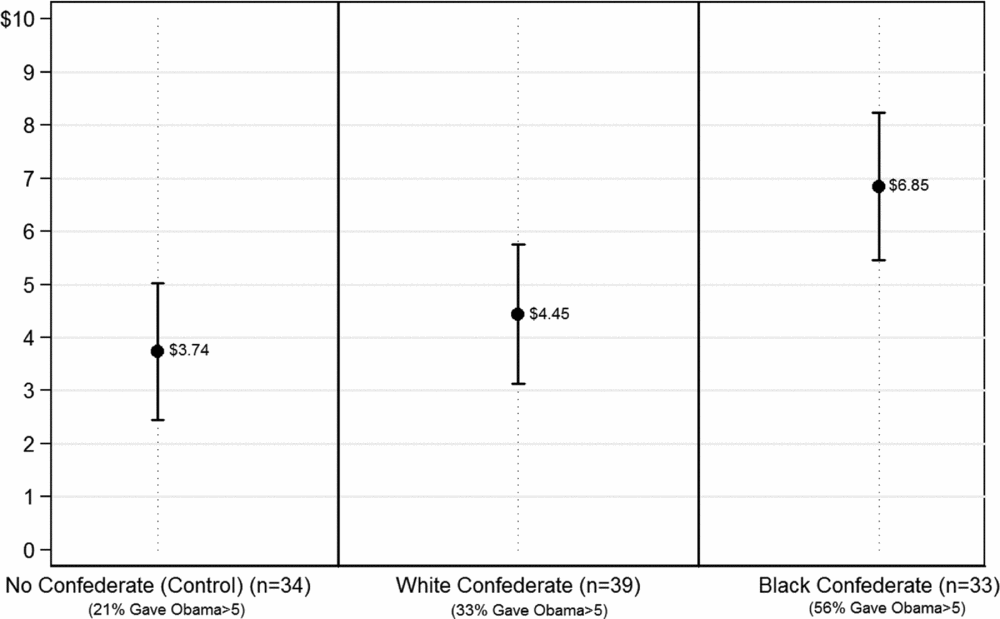
FIGURE 8. Experiment 2, Obama Campaign Contribution by Race of Confederate (95% Cl)
EXPERIMENT 3—SOCIAL PRESSURE TO DEFECT
In the previous experiments, we demonstrated the power of racialized social pressure to induce African Americans to conform to a norm of black political behavior. Our theory about the process of in-group constraint on members’ behavior, however, also implied that such pressure should not be effective in inducing behavior that contrasts with crystallized group norms. We tested this implication of our argument in this experiment, using elements from each of the previous experiments to assess the effects of social pressure on encouraging defection from the group norm. Subjects each received a treatment protocol that was in form like that of the incentive condition in Experiment 1: They were told that for every $10 (of $100 total) they allocated to the Romney campaign they would receive a $1 personal payout. This time, however, we placed this decision inside a context that included the subject and a confederate, each being asked to make his or her own allocation decision. The confederate was always black and was always asked to make his or her decision first. We randomly assigned, however, whether the confederate forwent the incentive and gave all the money to the Obama campaign (Obama confederate) or took the incentive and gave all the money to the Romney campaign (Romney confederate). Fifty-six self-identified black students from a predominantly white university participated in this study.Footnote 27
Hypotheses
Our expectations for this simple experiment were a bit nuanced. We expected that the presence of another black student complying with the norm of supporting Obama and monitoring the subject's contribution decisions should be an effective form of racialized social pressure. Thus, we expected that those in the Obama confederate condition should exhibit a high degree of compliance with the in-group norm to allocate all of the money to Obama despite the self-interest incentive to defect. Our theory implies, however, that the confederate's violation of the norm should not have the effect of racialized social pressure. Given the crystallized group norm of Obama support, we expected that the Romney confederate condition should only enable defection in favor of self-interest in the sense that it communicates that the other black person present is not performing the task of social monitoring. Given that in Experiment 1 we observed a fair degree of compliance with the group norm of supporting Obama even in the face of a self-interest incentive—in part as a function of internalized group solidarity—we expected the Romney confederate condition would induce lower compliance than the Obama confederate condition, but would not be effective in pushing acceptance of the self-interest payout for contributions to Romney to particularly high levels.
Results
Again, we present mean differences in Obama contributions across the conditions to assess the results of this experiment (see Figure 9). Consistent with our previous results, subjects in the Obama confederate condition nearly universally allotted all of the possible campaign funds to Obama, despite the self-interest incentive to give to Romney. Though subjects in the Romney confederate condition gave significantly less to Obama, their mean contribution to Obama was still more than $70. In fact, the difference across these two conditions is about the same as that observed between the control and incentive-only conditions in Experiment 1.Footnote 28 Thus the difference across these two conditions seems more consistent with an interpretation that subjects in the Romney confederate condition perceived the confederate's actions as a cue that they were not being monitored for their adherence to the group norm, rather than as an effective act of racialized social pressure to violate the group norm.
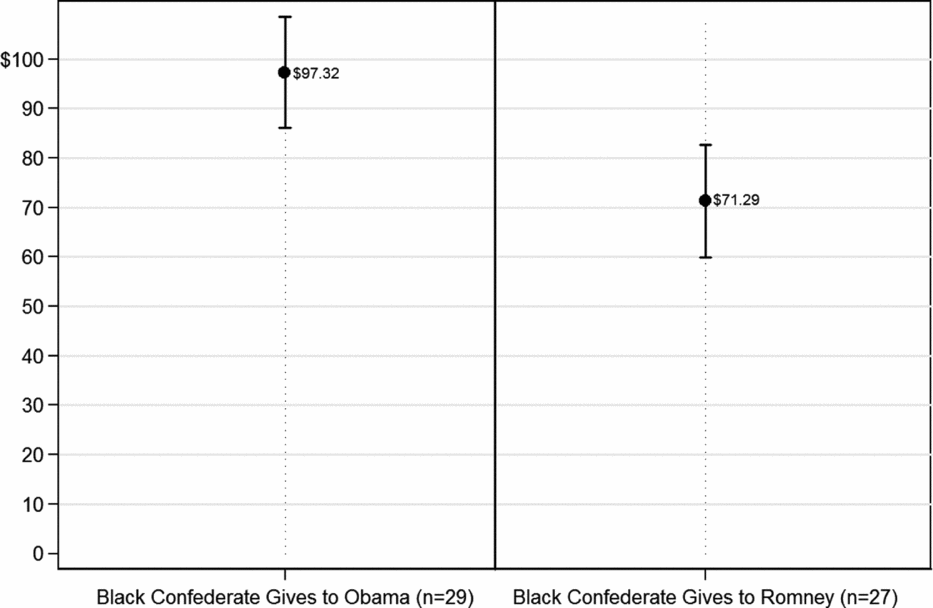
FIGURE 9. Experiment 3, Obama Contribution by Experimental Condition (95% Cl)
CONCLUSION
Despite the high degree of political solidarity often observed among African Americans, our results show that the ties that bind blacks together can be undone by appeals to self-interest. Indeed, in this context, where the self-interest involved clear but small monetary gains, self-interest was readily traded for a political behavior that seemed incredibly well understood as being in the racial group interest. Our results, then, are consistent with narratives that warn of “selling out” the interest of blacks, which depend on a reality that some blacks are willing to accept private incentives to defect from group norms of political behavior. Yet, we also observed that not all blacks were equally vulnerable to such incentives. The willingness to defect depended importantly on internalized values, with those blacks who had internalized a strong attachment to money being most willing to trade a small personal gain for the group's larger interest, and those blacks who had internalized beliefs in the importance of maintaining racial group solidarity being least vulnerable to the self-interest incentive. This variation is worth underscoring. Although it has become almost common knowledge that blacks share a common political interest, we have shown that the degree of dedication to this collective interest can vary greatly and systematically when the choice at hand is the maximization of group interest versus self-interest.
For those interested in maintaining black group solidarity as a means to make further gains toward social and political equality for the racial group, our results may be troubling. They raise important questions about how to maintain black collective action in the face of personal incentives offered to members of the racial group to betray the shared interests of the group. Most centrally, does black economic progress mean an end to black politics, as wealthier blacks become more concerned with their economic self-interest than with their racial group interest? The results of our introduction of racialized social pressure show that might not be the case. Strikingly, both the very public “outing” of advertising defection in the university's newspaper and the far more interpersonal “outing” of simply having defection observed by another black person—a complete stranger—worked as mechanisms for constraining defection. This consistent racialized social pressure effect suggests that blacks can powerfully police one another's behavior, keeping group members in line with group expectations of political behavior and ultimately preventing free-riding.
Yet, there are caveats about the power of such policing. First, our results suggest that it depends importantly on values—value placed of the social ties that bind the group and on the personal benefits available by defecting. That the constraining power of social pressure was conditioned by beliefs in the use of social sanctions, rather than by a sense of linked fate, speaks to the notion that internal social processes of the group, not just common interests defined by the broader political system, are essential to maintaining political cohesion. Similarly, although those who internally valued money more were more likely to defect, we also found significant variation in such a value, suggesting that there is potential leverage for maintaining group cohesion by using black social and political institutions as purveyors of these values. Still, because our experiments only offered small monetary incentives to pursue self-interest, important questions remain to be answered about where lie the tipping points of tradeoffs between self-interest versus social sanctions to comply with group interest. More work is likely needed to sort out how blacks’ perceptions of incentives and social pressure might change as they age and their racial identities become more crystallized.
Our results also point to other limits to the political potential of social pressure. They support our argument that social pressure would be particularly effective when it is centered on a highly crystallized and intense group norm for blacks in their roles as citizens. The use of racialized social pressure to enforce group norms was much more effective than the use of such social pressure to encourage defection from the group norm. In particular, our finding that a Romney-supportive black confederate fell far short of pushing most of our subjects to defect from supporting Obama speaks to the mostly fruitless efforts of Republicans to recruit black support through endorsements by black figures or candidacies of black Republicans. The group norm of Democratic support is far too highly crystallized and intense for behavior in contradictory terms to be understood as socially acceptable with such cues. Republicans, it would seem, face a daunting challenge of changing the norms within the black community before their party has a chance at winning significant political support from African Americans.Footnote 29 Yet, perhaps stronger social signals than the ones we—or the Republican Party—have offered could work to encourage defection from the group norm. Thus, more work in this direction seems both theoretically and politically consequential.
We would also be remiss if we did not note that the power of racialized social sanctions evokes difficult normative questions. If the effectiveness of racialized social pressure hinges so centrally on what is understood to be key to the racial group interest, then the social processes that create that understanding are important. Cathy Cohen (Reference Cohen1999) has written powerfully about how the interests of some blacks have been defined out of the black political agenda—how leaders within the black community, for example, had for so long been unwilling to push for addressing the HIV/AIDS epidemic in the black community as a racial group issue. Our work, in some ways, magnifies her concerns. It suggests that not only would there be difficulty in mobilizing black politics to address the epidemic but also that there are incentives that would keep even those blacks whose self-interest was defined by HIV/AIDS—those who suffered from the disease personally or through close personal ties—from feeling able to push for political attention to the cause. Because the issue is so clearly defined as “not black,” the constraint of racialized social pressure seems likely to have suppressed important and legitimate expressions of self-interest. The inclusiveness of the processes that define the black political agenda, therefore, becomes all the more important if black politics are to serve the interest of all black Americans.
Finally, though we have focused on the case of black Americans, our results speak more broadly to the politics of navigating conflicts between a salient group interest and self-interest. The model we have offered is one that sheds light on how group cohesion can be effectively achieved even as self and group diverge perceptibly. To understand its applicability and implications for other group identifications, work will have to be done about the venues for political group norm development and social sanctioning and whether other groups have the same potential to enable highly crystallized and intense political norms and the effective social enforcement of them. Religious communities tied by strong beliefs and strong institutions seem prime targets for such study. Consideration of whether other racial and ethnic communities can attain the same political cohesion as blacks in pursuit of greater political equality would benefit from determining whether those communities have similar tools for navigating conflicts between group and self-interests.














Comments
No Comments have been published for this article.